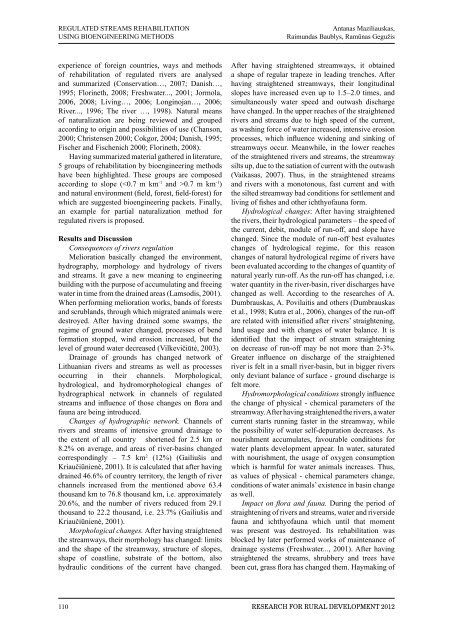RESEARCH FOR
RESEARCH FOR
RESEARCH FOR
You also want an ePaper? Increase the reach of your titles
YUMPU automatically turns print PDFs into web optimized ePapers that Google loves.
REGULATED STREAMS REHABILITATION<br />
USING BIOENGINEERING METHODS<br />
experience of foreign countries, ways and methods<br />
of rehabilitation of regulated rivers are analysed<br />
and summarized (Conservation…, 2007; Danish…,<br />
1995; Florineth, 2008; Freshwater..., 2001; Jormola,<br />
2006, 2008; Living…, 2006; Longinojan…, 2006;<br />
River..., 1996; The river …, 1998). Natural means<br />
of naturalization are being reviewed and grouped<br />
according to origin and possibilities of use (Chanson,<br />
2000; Christensen 2000; Cokgor, 2004; Danish, 1995;<br />
Fischer and Fischenich 2000; Florineth, 2008).<br />
Having summarized material gathered in literature,<br />
5 groups of rehabilitation by bioengineering methods<br />
have been highlighted. These groups are composed<br />
according to slope (0.7 m km -1 )<br />
and natural environment (field, forest, field-forest) for<br />
which are suggested bioengineering packets. Finally,<br />
an example for partial naturalization method for<br />
regulated rivers is proposed.<br />
results and discussion<br />
Consequences of rivers regulation<br />
Melioration basically changed the environment,<br />
hydrography, morphology and hydrology of rivers<br />
and streams. It gave a new meaning to engineering<br />
building with the purpose of accumulating and freeing<br />
water in time from the drained areas (Lamsodis, 2001).<br />
When performing melioration works, bands of forests<br />
and scrublands, through which migrated animals were<br />
destroyed. After having drained some swamps, the<br />
regime of ground water changed, processes of bend<br />
formation stopped, wind erosion increased, but the<br />
level of ground water decreased (Vilkevičiūtė, 2003).<br />
Drainage of grounds has changed network of<br />
Lithuanian rivers and streams as well as processes<br />
occurring in their channels. Morphological,<br />
hydrological, and hydromorphological changes of<br />
hydrographical network in channels of regulated<br />
streams and influence of those changes on flora and<br />
fauna are being introduced.<br />
Changes of hydrographic network. Channels of<br />
rivers and streams of intensive ground drainage to<br />
the extent of all country shortened for 2.5 km or<br />
8.2% on average, and areas of river-basins changed<br />
correspondingly – 7.5 km 2 (12%) (Gailiušis and<br />
Kriaučiūnienė, 2001). It is calculated that after having<br />
drained 46.6% of country territory, the length of river<br />
channels increased from the mentioned above 63.4<br />
thousand km to 76.8 thousand km, i.e. approximately<br />
20.6%, and the number of rivers reduced from 29.1<br />
thousand to 22.2 thousand, i.e. 23.7% (Gailiušis and<br />
Kriaučiūnienė, 2001).<br />
Morphological changes. After having straightened<br />
the streamways, their morphology has changed: limits<br />
and the shape of the streamway, structure of slopes,<br />
shape of coastline, substrate of the bottom, also<br />
hydraulic conditions of the current have changed.<br />
Antanas Maziliauskas,<br />
Raimundas Baublys, Ramūnas Gegužis<br />
After having straightened streamways, it obtained<br />
a shape of regular trapeze in leading trenches. After<br />
having straightened streamways, their longitudinal<br />
slopes have increased even up to 1.5–2.0 times, and<br />
simultaneously water speed and outwash discharge<br />
have changed. In the upper reaches of the straightened<br />
rivers and streams due to high speed of the current,<br />
as washing force of water increased, intensive erosion<br />
processes, which influence widening and sinking of<br />
streamways occur. Meanwhile, in the lower reaches<br />
of the straightened rivers and streams, the streamway<br />
silts up, due to the satiation of current with the outwash<br />
(Vaikasas, 2007). Thus, in the straightened streams<br />
and rivers with a monotonous, fast current and with<br />
the silted streamway bad conditions for settlement and<br />
living of fishes and other ichthyofauna form.<br />
Hydrological changes: After having straightened<br />
the rivers, their hydrological parameters – the speed of<br />
the current, debit, module of run-off, and slope have<br />
changed. Since the module of run-off best evaluates<br />
changes of hydrological regime, for this reason<br />
changes of natural hydrological regime of rivers have<br />
been evaluated according to the changes of quantity of<br />
natural yearly run-off. As the run-off has changed, i.e.<br />
water quantity in the river-basin, river discharges have<br />
changed as well. According to the researches of A.<br />
Dumbrauskas, A. Povilaitis and others (Dumbrauskas<br />
et al., 1998; Kutra et al., 2006), changes of the run-off<br />
are related with intensified after rivers’ straightening,<br />
land usage and with changes of water balance. It is<br />
identified that the impact of stream straightening<br />
on decrease of run-off may be not more than 2-3%.<br />
Greater influence on discharge of the straightened<br />
river is felt in a small river-basin, but in bigger rivers<br />
only deviant balance of surface - ground discharge is<br />
felt more.<br />
Hydromorphological conditions strongly influence<br />
the change of physical - chemical parameters of the<br />
streamway. After having straightened the rivers, a water<br />
current starts running faster in the streamway, while<br />
the possibility of water self-depuration decreases. As<br />
nourishment accumulates, favourable conditions for<br />
water plants development appear. In water, saturated<br />
with nourishment, the usage of oxygen consumption<br />
which is harmful for water animals increases. Thus,<br />
as values of physical - chemical parameters change,<br />
conditions of water animals’ existence in basin change<br />
as well.<br />
Impact on flora and fauna. During the period of<br />
straightening of rivers and streams, water and riverside<br />
fauna and ichthyofauna which until that moment<br />
was present was destroyed. Its rehabilitation was<br />
blocked by later performed works of maintenance of<br />
drainage systems (Freshwater..., 2001). After having<br />
straightened the streams, shrubbery and trees have<br />
been cut, grass flora has changed them. Haymaking of<br />
110 ReseaRch foR RuRal Development 2012


